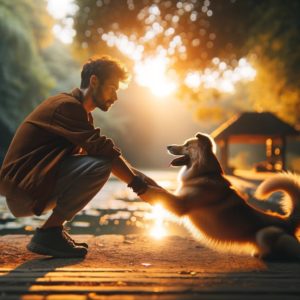It’s a common phenomenon among pet owners to attribute human-like characteristics and emotions to their beloved animal companions. This psychological process, known as anthropomorphism, speaks volumes about our deep desire for connection and understanding. However, despite its innocent intent, anthropomorphism can also muddy the waters of our understanding, leading to misinterpretations of our pets’ behaviors and emotional states. As pet owners, it’s crucial to delve deeper into the concept of anthropomorphism to ensure we provide the most appropriate care for our pets.
Chapter 1: Anthropomorphism: A Human Lens on Animal Behavior
Anthropomorphism and Its Role in Human-Animal Relationships
Pets hold a special place in our lives. They are not just our companions but also members of our families, with whom we share a deep emotional bond. This connection often prompts us to interpret their actions and behaviors in a way that’s familiar to us. This process, known as anthropomorphism, is an instinctive human trait that has played a significant role in how we relate to and interact with animals throughout history. However, what exactly is anthropomorphism? And what implications does it have for our understanding of animal behavior? This blog post aims to explore these questions, delving into the concept of anthropomorphism and its impact on our relationships with our pets.
Understanding Anthropomorphism
At its core, anthropomorphism refers to the tendency to attribute human emotions, thoughts, or intentions to non-human entities. This includes everything from ascribing human-like personalities to our pets to interpreting their behaviors through a human-centric lens. For example, when we say that a dog is feeling “guilty” for knocking over a trash can or that a cat is “jealous” because it’s not receiving enough attention, we are anthropomorphizing these animals. We are interpreting their actions based on how we understand and express these emotions as humans.
The Origin of Anthropomorphism
Anthropomorphism springs from our ability to empathize and relate to other beings. As humans, we are social creatures who instinctively try to understand the world around us based on our own experiences and emotions. This natural instinct extends to our relationships with animals, especially those we keep as pets. We form strong emotional bonds with our pets, and anthropomorphism enhances these bonds by allowing us to relate to our pets on a more personal level. It enables us to feel more connected to them, which is crucial in building a loving and nurturing relationship.
The Positive Side of Anthropomorphism
Anthropomorphism can have several positive implications. It fosters empathy towards animals, encourages humane treatment, and enhances the human-animal bond. It helps us recognize animals as sentient beings with their unique personalities and emotional states, contributing to their welfare and quality of life. It also plays a significant role in storytelling, allowing us to create engaging narratives that help raise awareness about animal rights and conservation issues.
Unpacking the Complexities of Anthropomorphism
Despite these benefits, anthropomorphism isn’t without its complexities. While it can help us feel closer to our pets, it can also lead to misunderstandings and misinterpretations of animal behavior. But what does this mean for our relationships with our pets? How can we navigate the intricacies of anthropomorphism to ensure we understand our pets’ behaviors accurately and care for them appropriately? These are the questions we’ll explore in the next section of this blog series.
The Interplay of Anthropomorphism and Animal Understanding
Understanding anthropomorphism is a crucial step in deepening our comprehension of animal behavior. It requires us to strike a delicate balance – to empathize with our pets and relate to them while also recognizing the differences in how they express and experience the world. By doing so, we can foster more meaningful and fulfilling relationships with our animal companions, marked by mutual respect and understanding. Stay tuned for the next installment in this series, where we’ll delve deeper into the implications of anthropomorphism and how we can navigate its complexities.







